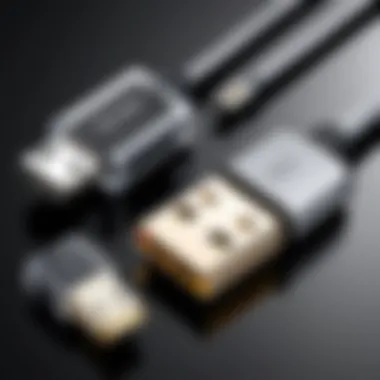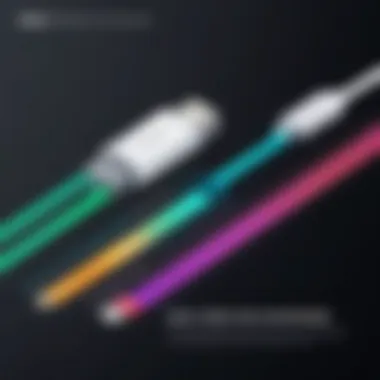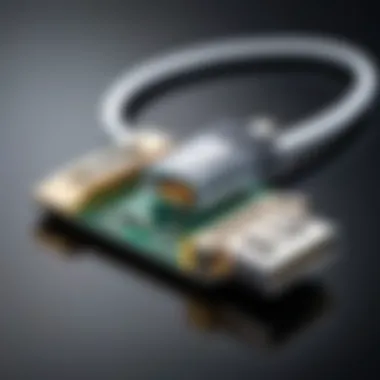Understanding SS USB Cable Technology for Professionals


Intro
The evolution of data transfer technology has significantly shaped how devices communicate and share information. Among these advancements, the SS (SuperSpeed) USB cable stands out as a pivotal element in supporting high-speed data communication. This section provides a clear overview, establishing the relevance of SS USB cables in the modern tech landscape.
SuperSpeed USB cables facilitate swift connections and efficient data exchange between a multitude of devices, such as computers, smartphones, and external storage systems. They follow a set of rigorous specifications that ensure maximum performance. As the demand for higher transfer rates continues to grow, understanding the intricacies of SS USB technology becomes essential for IT professionals and tech enthusiasts alike.
Hardware Overview
Specifications
The specifications of SS USB cables are key to their performance capabilities. SS USB technology was first introduced with USB 3.0, supporting a theoretical maximum transfer speed of up to 5 Gbps. Subsequent versions, such as USB 3.1 and USB 3.2, enhanced these capabilities to 10 Gbps and even 20 Gbps, respectively.
A few critical specifications include:
- Connector Types: USB-A, USB-B, USB-C are common types found in SS designs.
- Cable Length: The length of SS USB cables can affect performance; usually, lengths upwards of 3 meters may experience decreased efficiency.
- Power Delivery: Many SS cables support power delivery protocols, enabling faster charging of devices.
Performance Metrics
Performance metrics play a crucial role in determining the utility of SS USB cables. Evaluating these can help narrow down options when selecting the right cable for specific applications. Some significant performance metrics include:
- Data Transfer Speed: Actual transfer speeds can vary based on device compatibility and the type of data being transferred.
- Durability and Build Quality: Quality cables are built to withstand frequent use, minimizing the risk of wear and tear.
- Compatibility: SS USB cables are generally backward compatible with previous USB standards, making them flexible in use.
"The advancements in SS USB technology not only impact data transfer speeds but also enhance device interoperability."
Understanding these hardware aspects allows one to make informed decisions, ensuring optimal performance in various applications.
Software Analysis
Features and Functionality
The features of SS USB cables extend beyond mere physical specifications. They offer a range of functionalities that enhance connectivity. One of the significant advantages is their capability to transfer not just data, but also power, through the same cable.
User Interface and Experience
A seamless user experience is facilitated through the implementation of SS USB technology in numerous devices. Users benefit from faster charging, quicker file transfers, and a straightforward plug-and-play interface. This simplicity encourages widespread adoption across various sectors, making SS USB cables a standard choice for many electronic devices.
Prolusion to SS USB Cables
In today’s rapidly advancing technological landscape, the significance of SS (SuperSpeed) USB cables cannot be overstated. These cables play a critical role in enabling fast and efficient data transfers across a variety of devices. They are an essential component in establishing seamless connectivity, which is fundamental for both personal and professional use. This article delves into the core aspects of SS USB technology, shedding light on its specifications, applications, and the impact it has on modern data communication.
Definition of SS USB
The term SS USB refers to the SuperSpeed USB technology, which is an evolution of the standard USB interface. This technology offers higher data transmission rates compared to its predecessors. It was introduced with USB 3.0 and has been refined in subsequent standards like USB 3.1 and USB 3.2. SuperSpeed USB can achieve data transfer rates of up to 5 Gbps initially, then scaling up to 10 Gbps and 20 Gbps with later versions. The design includes enhancements in cable design, signal processing, and protocols, improving both performance and efficiency in data handling.
Importance in Technology
SS USB cables are crucial for various reasons:
- Increased Performance: They enable significantly faster file transfers, which is vital for applications that require large data movements, such as video editing or software development.
- Enhanced Connectivity: These cables provide improved connectivity features. They support not just data transfer, but also the capability to deliver power to devices.
- Widespread Adoption: As technology evolves, the current landscape of consumer electronics increasingly relies on SS USB connections. From smartphones to external hard drives, the use of these cables is becoming standardized.
- Future-Proofing: Understanding SS USB technology prepares users for emerging technologies and standards, ensuring they can adapt to new devices without major changes in infrastructure.


"The evolution of USB technology signifies a shift not just in speed, but also in how devices interact and share data across multiple platforms."
Overall, SS USB cables are a fundamental aspect of modern technology. Their advantages in speed, efficiency, and utility encompass a wide range of applications, making them indispensable in the tech world.
Technical Specifications of SS USB
The technical specifications of SS USB cables play a crucial role in defining their performance and applicability in various scenarios. For IT professionals and tech enthusiasts alike, understanding these specifications is vital. It helps in making informed decisions regarding device compatibility, efficiency, and suitability for specific tasks. Key aspects include data transfer rates, power delivery capabilities, and the materials used in cable construction. These specifications collectively determine how effectively a cable can serve its intended purpose in today’s high-speed technology landscape.
Data Transfer Rates
SS USB cables are designed to support high data transfer speeds, significantly enhancing the efficiency of data communication between devices. The transfer rates vary based on the SS USB version, with USB 3.0 supporting up to 5 Gbps, while USB 3.1 extends this to 10 Gbps. This increase in speed is crucial, especially for applications that require rapid data exchange, such as video editing or large file backups.
Key points about data transfer rates include:
- Real-time performance: Faster transfer speeds can reduce wait times when sending or receiving large files.
- Improved multitasking: Higher data rates enable smoother operation of multiple connected devices simultaneously.
- Future-proofing: As file sizes continue to grow, faster cables ensure compatibility with upcoming technologies.
Understanding these aspects aids users in selecting the appropriate cable for their needs and investing in technology that matches their data demands.
Power Delivery Standards
Power delivery is an essential specification of SS USB technologies. Power Delivery (PD) allows a device to charge faster and supports various power levels, up to 100 watts. This is particularly beneficial for devices like laptops, which traditionally relied on separate power adapters.
The importance of power delivery standards can be summarized as follows:
- Increased efficiency: Devices charge faster without compromising battery life, minimizing downtime.
- Versatility: A single cable can provide power to multiple device types, simplifying connectivity.
- Safety features: USB PD includes protocols to ensure safe transmission of power, preventing overheating or overload.
This allows a more streamlined setup for users who need robust charging solutions alongside data transfer.
Cable Construction and Materials
The construction and materials used in SS USB cables are critical for longevity, performance, and safety. High-quality materials ensure optimal performance across various conditions. SS USB cables often utilize a combination of copper wire and durable insulation materials to enhance durability and reduce signal loss.
Consider these aspects of cable construction:
- Copper quality: The type and gauge of copper directly affect conductivity and, thus, transfer speeds.
- Insulation: High-quality insulation materials prevent signal interference and enhance durability against wear and tear.
- Connector design: Well-engineered connectors ensure a secure fit, which is vital for maintaining stable connections and preventing data loss.
Understanding the technical specifications of SS USB cables leads to more informed choices in selecting the right cable for specific applications, ensuring optimal performance and longevity.
Comparison with Other USB Standards
Understanding the differences between SS USB cables and other USB standards is crucial for users seeking to maximize their device compatibility and performance. The evolution of USB technology has introduced several versions, each with unique specifications and functionalities. An in-depth analysis of these comparisons will shed light on the advantages of SS USB, especially concerning speed, power delivery, and data transfer capabilities. Knowing these distinctions can significantly impact choices in purchasing and utilizing USB cables effectively.
USB 2. vs. USB 3.
USB 2.0, launched in 2000, is one of the most widely used standards. It offers a maximum data transfer rate of 480 Mbps. This speed was significant at the time but is now seen as insufficient in the modern tech landscape, where larger files and high-speed connections are the norm. In contrast, USB 3.0, introduced in 2008, boasts speeds up to 5 Gbps, making it more suitable for contemporary applications.
The key differences are:
- Speed: USB 3.0 is over ten times faster than USB 2.0.
- Power Management: USB 3.0 allows for more efficient power management, with the ability to provide up to 900 mA compared to USB 2.0's 500 mA.
- Connector Design: USB 3.0 connectors often have additional pins, thus they are backward compatible but not interchangeable with USB 2.0.
These variations highlight the necessity for users to upgrade to USB 3.0 cables when higher speeds are essential, particularly in industries reliant on rapid data transfer.


USB 3. and USB 3. Differences
USB 3.1, released in 2013, further enhances the capabilities of USB technology. It offers two modes: Gen 1, which runs at 5 Gbps similar to USB 3.0, and Gen 2, which can reach speeds of up to 10 Gbps. This doubling of speed makes it a valuable asset for professionals handling substantial data loads.
USB 3.2 builds on this foundation, allowing multiple lanes for data transmission. This means it can achieve data rates of up to 20 Gbps when using compatible cables and devices. Key points include:
- Backward Compatibility: Both USB 3.1 and USB 3.2 maintain backward compatibility with previous USB versions, ensuring that users can still utilize older devices.
- Connector Types: While USB 3.1 supports USB-C connections, USB 3.2 emphasizes the advantage of this new connector style, facilitating reversible insertion and more robust data transfer.
Understanding these differences allows for better decision-making regarding technology investments, particularly for tech enthusiasts and IT professionals who aim to stay ahead of the curve in device connectivity.
Applications of SS USB Cables
SS USB cables have become integral in a variety of technology sectors. Their ability to enhance data transfer rates and ensure efficient connectivity fundamentally shapes how devices interact. Understanding where and how these cables are utilized can inform choices for both consumers and professionals in the tech industry. Below, we examine key applications that showcase the versatility and importance of SS USB cables.
Consumer Electronics
In the realm of consumer electronics, SS USB cables serve critical functions. They enable fast data transfers between devices such as smartphones, tablets, and laptops. For example, using a USB 3.0 or USB 3.1 cable can significantly reduce the time it takes to transfer large files such as videos or high-resolution images. Consumers benefit from faster syncing, charging, and overall connectivity.
Moreover, many modern gadgets rely on these cables for their operation. Devices like external hard drives, cameras, and printers commonly feature SS USB ports. This compatibility allows users to connect multiple gadgets seamlessly, enhancing productivity and user experience.
Data Storage Devices
Data storage devices witness a substantial impact from SS USB cables. These cables support fast read and write speeds, making them essential for external SSDs and HDDs. Users expect efficient and quick access to their data, especially with increasing file sizes and the need for rapid backup solutions. The performance of storage devices can be significantly hindered without the appropriate cable.
With SS USB 3.0 and 3.1 standards, the data transfer rates reach impressive levels. This is especially relevant for professionals who work with large datasets or media files, as faster transfer times lead to improved workflow efficiency. Investing in high-quality SS USB cables ensures that the data integrity remains intact during transfers.
Networking Equipment
SS USB cables play a crucial role in networking equipment as well. Devices like routers and network switches often utilize SS USB connections for linking peripherals such as modems or external drives. These connections provide a robust method for data transfer, which is essential for maintaining network performance.
Additionally, with the growing trend of network-attached storage (NAS) systems, SS USB cables contribute to improved data access speeds. Within enterprise environments, where multiple users access and share data, ensuring optimal connectivity becomes vital.
In summary, the applications of SS USB cables extend across various sectors, significantly improving efficiency, data integrity, and user experience. Understanding these applications allows both tech enthusiasts and professionals to make informed choices regarding their devices and connectivity solutions.
Performance and Efficiency
Performance and efficiency are crucial factors in the realm of SS USB cable technology. The capabilities of these cables greatly influence how effectively devices communicate and transfer data. Understanding these factors provides insight into the advancements in USB technology and its applications.
Impact on Data Transfer Speeds
The primary advantage of SS USB cables lies in their enhanced data transfer speeds. SS USB refers to the SuperSpeed USB standard, which can achieve transfer rates of up to 5 Gbps with USB 3.0 and 10 Gbps with USB 3.1. These high speeds play a significant role in modern data requirements, especially for professionals who rely on swift file transfers, such as video editing or large data backups.
The efficiency of SS USB technology can be attributed to various technical enhancements that enable faster data transmission. For example, the utilization of higher signaling frequencies and improved data encoding techniques reduces the time required for data transmission. Additionally, SS cables support simultaneous data streams, which allows for more efficient communication between devices.
Given the data-driven nature of many industries today, the impact of SS USB on performance cannot be understated. It enables quicker access to large files, reduced wait times during data transfers, and improved system responsiveness in scenarios requiring frequent communication between devices.
Latency Considerations
Latency, or the delay before a transfer of data begins following an instruction for its transfer, is another critical aspect of performance. SS USB cables are designed to minimize latency, which enhances the overall efficiency of data communication. Low latency is particularly important in environments where real-time data processing is necessary, such as in gaming or video conferencing where a delay would disrupt the user experience.
In comparing SS USB technology to earlier standards, such as USB 2.0 and USB 3.0, it becomes clear that the advancements provide significant reductions in latency. SS USB technology allows for more immediate data acknowledgments between devices, which enhances the smoothness of operations. Users benefit from quicker loading times and a more responsive system overall.


"The importance of minimizing latency in data transfers is crucial for maintaining a seamless user experience."
Compatibility Issues
Understanding compatibility issues within the realm of SS USB cables is key for both consumers and professionals. As technology progresses, ensuring that devices work seamlessly together becomes crucial. Compatibility affects everything from data transfer speeds to charging capabilities. Addressing this topic helps clarify the practical implications of SS USB cables in everyday usage.
Cross-Compatibility with Devices
SS USB cables are designed to be versatile. They can connect to various devices that support the USB standard. However, complications can arise with certain combinations. For instance, older devices might not utilize the full potential of SS USB cables. This can result in reduced data transfer rates or even complete failure to connect.
- Backward Compatibility: One of the essential aspects of SS USB technology is its backward compatibility with earlier versions like USB 2.0 and USB 3.0. This means that a SS USB cable can typically connect with older devices. Yet, users should be aware that the performance might be throttled due to the older technology's limitations.
- Device Drivers: Ensuring that devices have the correct drivers installed can impact functionality. This is particularly relevant when connecting devices with different USB standards. Missing or outdated drivers could cause communication issues, leading to frustration.
In summary, while SS USB cables offer flexibility, users must acknowledge potential incompatibilities with older devices and systems.
Potential Limitations
Potential limitations of SS USB cables merit careful consideration. While these cables promise enhanced speed and power delivery, there are certain constraints that can impact user experience.
- Cable Quality: Not all SS USB cables are created equal. Low-quality cables can significantly diminish performance, leading to slower transfer speeds or disruptions in power delivery. Investing in certified cables can help mitigate these issues.
- Device Limits: Every device has specifications regarding the power it can draw through the USB port. This limitation can hinder the performance of devices connected through SS cables, particularly with high-performance equipment.
- Heat Management: High data transfer speeds may generate heat. Excessive heat could lead to throttling or damage over long usage periods. Proper heat management solutions may be necessary for high-demand applications.
Future of USB Technology
The future of USB technology is a critical area of discussion within the domain of device connectivity. As we continue to advance in our digital age, the performance, speed, and functionality of USB standards will evolve to meet new demands. Understanding these changes is essential for IT professionals and tech enthusiasts who need to keep pace with technological advancements. The utility of USB cables is becoming increasingly intertwined with emerging standards that cater to higher data transfer speeds and enhanced power delivery capabilities, reflecting the growing complexity of interconnected devices.
Emerging Standards
Emerging standards in USB technology signify a response to various challenges in the tech landscape. One of the most notable changes is the introduction of USB4, which aims to unify existing standards and introduce improved performance metrics.
- Data Transfer Speeds: USB4 can support speeds up to 40 Gbps, which is twice as fast as USB 3.2. This improvement is vital as applications for data-heavy tasks become common in both consumer and professional settings.
- Thunderbolt 3 Integration: USB4 integrates Thunderbolt 3, allowing for more versatile connectivity options. This compatibility extends the capabilities of USB devices by permitting connections with high-bandwidth peripherals.
- Improved Power Delivery: The new standards include enhancements in power delivery, facilitating faster charging of devices. The capability to deliver up to 100 Watts is crucial for larger devices, such as laptops, and reduces the need for separate power adapters.
Projected Trends in Connectivity
Looking forward, projected trends in connectivity highlight the increasing reliance on USB technology for various applications. As technology continues to advance, the following points are noteworthy:
- Increased Device Interconnectedness: With the rise of the Internet of Things (IoT), USB cables will play a significant role in connecting a broader array of devices, from wearables to smart home systems.
- Advent of Wireless USB: While traditional USB cables remain prevalent, wireless alternatives are gaining traction. The demand for ease of use and convenience drives the exploration of wireless USB standards that maintain high data transfer speeds without the physical limitations of cables.
- Focus on Sustainability: Future USB standards may include more sustainable materials. This shift addresses environmental concerns and aligns with trends in technology focusing on reducing carbon footprints.
"The evolution of USB technology not only enhances device compatibility but also influences broader trends in technology developments globally."
As emerging standards and connectivity trends unfold, the role of SS USB cables will remain pivotal. Ensuring devices are equipped to handle future requirements will lead to better performance, efficiency, and user experience.
Finale
The conclusion chapter serves a critical purpose in this article on SS USB cable technology. It summarizes the insights provided throughout the discussions and emphasizes their importance. Understanding SS USB technology is not just academic; it is relevant for practical application in today's high-speed data communication environment.
Summary of Key Insights
In the previous sections, several key aspects were highlighted. First, SS USB cables offer significantly enhanced data transfer rates compared to older standards, which is essential for consumers and industries that rely on quick access to information. The technical specifications detail these advantages, showcasing how power delivery also plays a vital role in usability, reducing the need for multiple adapters.
Another important point is the comparison with other USB standards. This contextual understanding helps users choose the right cable for their specific needs, leading to better investment decisions in technology.
Applications discussed, ranging from consumer electronics to networking equipment, illustrate the versatility of these cables in various contexts. This underlines their relevance not just to IT professionals but also to everyday users.
Finally, the exploration of the future of USB technology shows an evolving landscape. Emerging standards promise even faster and more efficient options down the line. Staying informed about these trends is imperative for those involved in technology development and IT management, ensuring they remain competitive and knowledgeable in the ever-advancing field.
"Understanding the nuances of SS USB technology equips professionals with the knowledge to make informed decisions and maximize the efficiency of their technological environment."
In summary, the importance of SS USB technology is multifaceted, affecting data transfer efficiency, device compatibility, and the future of connectivity. Engaging with this content allows readers to deepen their understanding and enhances their ability to navigate an increasingly complex tech landscape.



